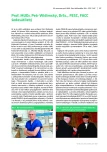Combination therapy of hypertension
Authors:
Jiří Widimský jr.
Authors‘ workplace:
Centrum pro hypertenzi III. interní kliniky 1. LF UK a VFN Praha, přednosta prof. MUDr. Štěpán Svačina, DrSc., MBA
Published in:
Vnitř Lék 2014; 60(4): 396-400
Category:
60th Birthday - prof. MUDr. Petr Widimský, DrSc., FESC, FACC
Overview
Arterial hypertension is not adequately controlled in many countries. One of the main reasons of poor control in clinical praxis is inappropriate use of combination therapy. It is estimated, that combination of at least two antihypertensive drugs is necessary in 70–80 % of all patients suffering from hypertension. The article summarizes current knowledge and recommendation for the use of combination strategy as well as the indications for various modalities of treatment. Combination of two drugs in low doses can be used already at the beginning of pharmacological therapy, especially in moderate to severe hypertension. Early implementation of combination therapy may improve blood pressure control and positively influence the prognosis.
Key words:
combination treatment – hypertension – indications
Sources
1. Filipovský J, Widimský jr. J, Ceral J et al. Diagnostické a léčebné postupy u arteriální hypertenze – verze 2012. Doporučení České společnosti pro hypertenzi. Vnitř Lék 2012; 58(10): 785–801.
2. Mancia G, Fagard R, Narkiewicz K et al. 2013 ESH/ESC Guidelines for the management of arterial hypertension. J Hypertension 2013; 31(7): 1281–1357.
3. Wald DS, Law M, Morris JK et al. Combination therapy versus monotherapy in reducing blood pressure: meta-analysis on 11,000 participants from 42 trials. Am J Med 2009; 122(3): 290–300.
4. Julius S, Kjeldsen SE, Weber M et al (VALUE trial group). Outcomes in hypertensive patients at high cardiovascular risk treated with regimens based on valsartan or amlodipine: the VALUE randomised trial. Lancet 2004; 363(9426): 2022–2031.
5. Corrao G, Nicotra F, Parodi A et al. Cardiovascular protection by initial and subsequent combination of antihypertensive drug in daily life practice. Hypertension 2011; 58(4): 566–572.
6. Gradman AH, Parisé H, Lefebvre P et al. Initial combination therapy reduces the risk of cardiovascular events in hypertensive patients: a matched cohort study. Hypertension 2013; 61(2): 309–318.
7. Gupta AK, Arshad S, Poulter NR Compliance, safety and effectiveness of fixed dose combinations of antihypertensive agents: a meta-analysis. Hypertension 2010; 55(2): 399–407.
8. Hess G, Hill J, Lau H et al. Medication utilization patterns and hypertension-related expenditures among patients who were switched from fixed-dose to free-combination antihypertensive therapy. P T 2008; 33(11): 652–655.
9. Dahlöf B, Sever PS, Poulter NE et al (ASCOT Investigators). Prevention of cardiovascular events with an antihypertensive regimen of amlodipine adding perindopril as required versus atenolol adding bendroflumethiazide as required, in the Anglo-Scandinavian Cardiac Outcomes Trial-Blood Pressure Lowering Arm (ASCOT-BPLA). Lancet 2005; 366(9489): 895–906.
10. Jamerson K, Weber MA, Bakris GL et al (ACCOMPLISH Trial Investigators). Benazepril plus amlodipine or hydrochlorothiazide for hypertension in high-risk patients. N Engl J Med 2008; 359(23): 2417–2428.
11. Matsuzaki M, Ogihara T, Umemoto S et al (Combination Therapy Of Hypertension to Prevent Cardiovascular Events Trial Group). Prevention of cardiovascular events with calcium channel blocker-based combination therapies in patients with hypertension: a randomized controlled trial. J Hypertens 2011; 29(8): 1649–1659.
12. Yusuf S, Teo KK, Pogue J et al (ONTARGET Investigators). Telmisartan, ramipril or both in patients at high risk for vascular events. N Engl J Med 2008; 358(15): 1547–1559.
13. Fried LF, Emanuele N, Zhang JH et al (VA NEPHRON-D Investigators). Combined angiotensin inhibition for the treatment of diabetic nephropathy. N Engl J Med 2013; 369(20): 1892–1903.
14. Gradman AH. Rationale for triple- combination therapy for management of high blood pressure. J Clin Hypertens (Greenwich) 2010; 12(11): 869–878.
Labels
Diabetology Endocrinology Internal medicineArticle was published in
Internal Medicine

2014 Issue 4
Most read in this issue
- Liver in heart failure
- Right ventricle in severe pulmonary hypertension in congenital heart defects – different and specific.
- Operation of Ebstein anomaly in adulthood – our experience
- Mitral stenosis
